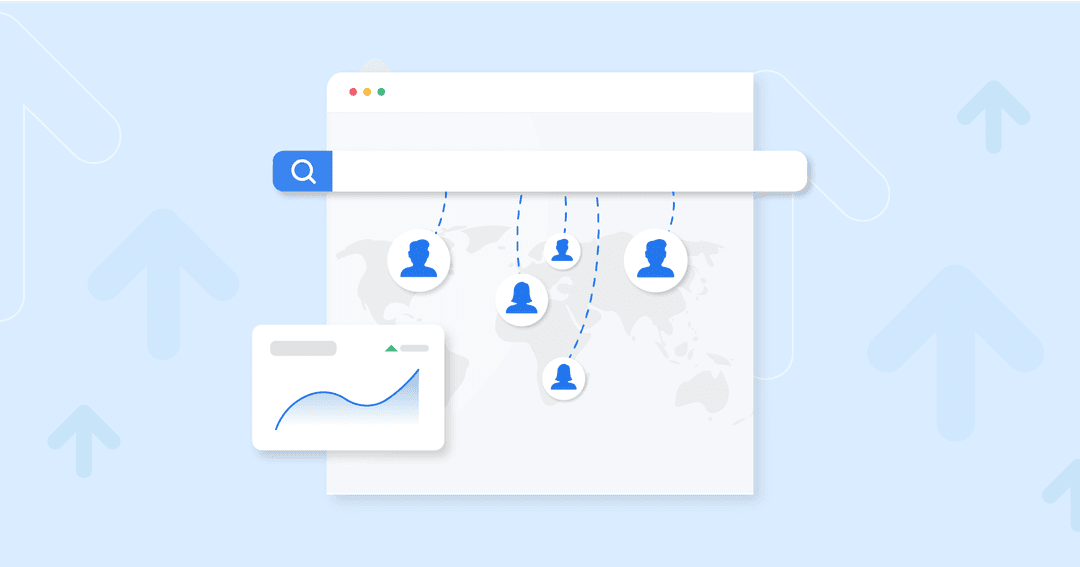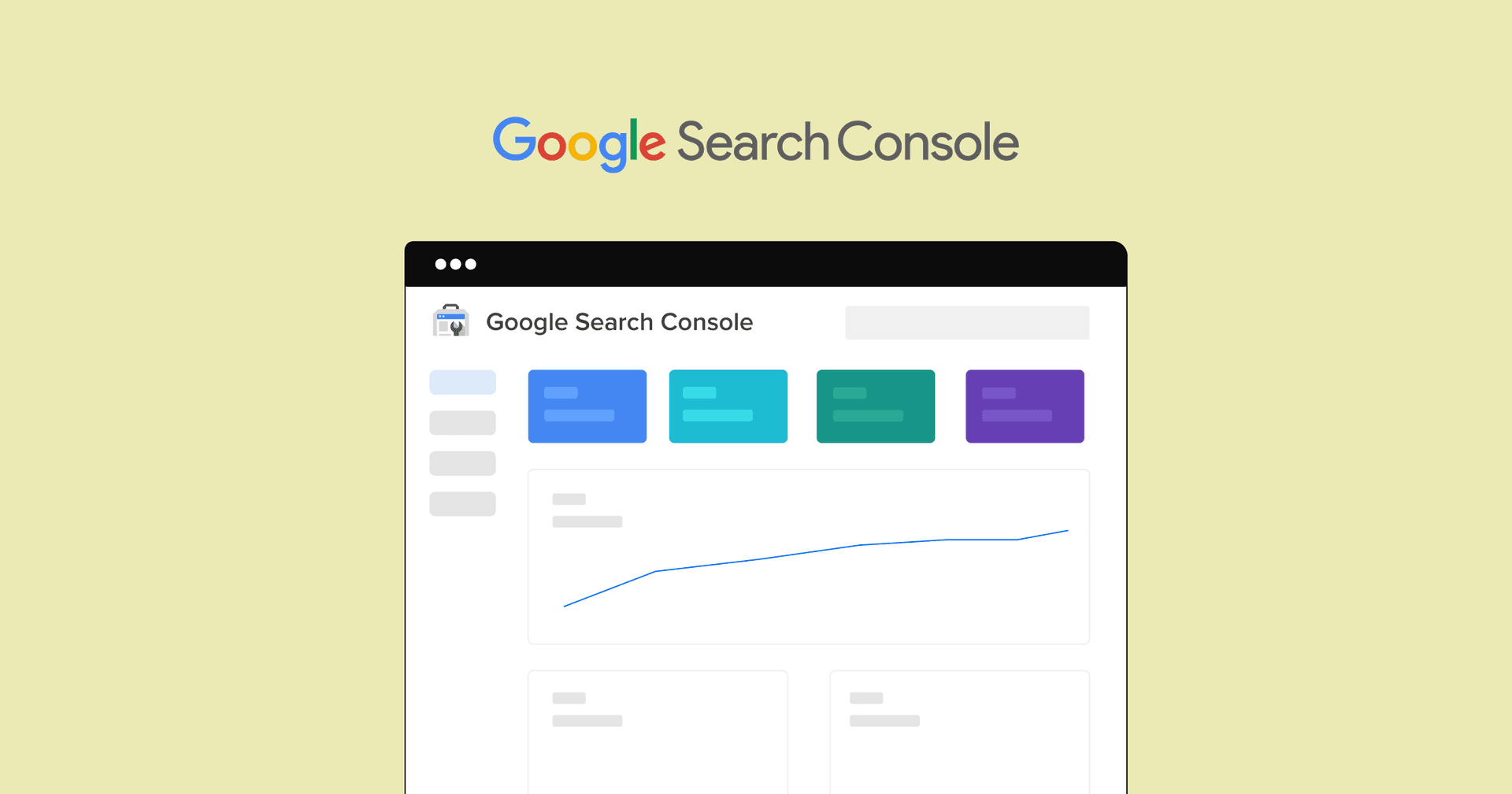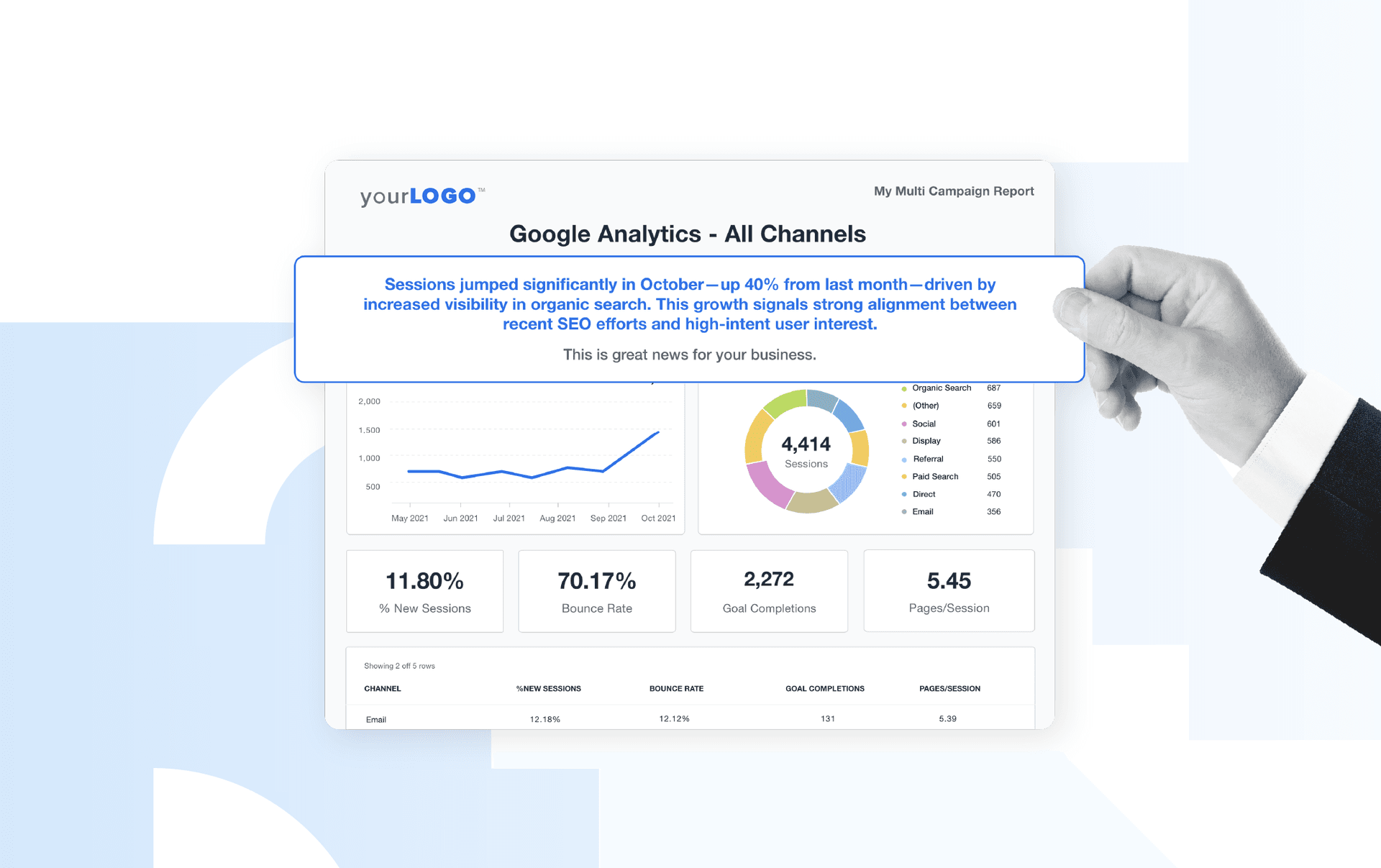Table of Contents
Table of Contents
- Explaining SEO traffic to your clients
- How SEO generates traffic (and why that’s evolving)
- Why answer engine optimization (AEO) matters now (more than ever)
- How SEO generates traffic
- Why SEO traffic strategies need to expand beyond classic SEO
- 8 ways to increase your clients’ SEO traffic
- When should your clients expect to see SEO results?
- The takeaway
7,000+ agencies have ditched manual reports. You can too.
Free 14-Day TrialQUICK SUMMARY:
SEO traffic, the influx of visitors to a website through organic search engine results, is crucial for online visibility. This article explores effective strategies to boost SEO traffic, highlighting the long-term benefits of investing in comprehensive SEO campaigns.
Today’s search ecosystem is evolving rapidly — many people now rely not just on traditional search engines, but on AI-powered answer engines, voice assistants, and instant‑answer results. That means increasing SEO traffic for your clients isn’t just about keywords and links anymore. It’s about matching user intent, delivering clear answers, and optimizing for both human readers and the systems that serve up instant results.
Search engine optimization is crucial to make your clients’ websites more visible–resulting in more traffic and opportunities to convert prospects into customers. But how do you go about increasing it for your clients?
In order to build an effective SEO strategy, the main objective should focus on boosting their online and offline traffic.
And how does your agency showcase that the long-term investment in SEO services is benefiting your client’s bottom line?
Although it may take months to show your clients the gains you’re getting them, your agency needs to communicate that the wait is worth it.
Using a marketing dashboard to monitor your clients’ SEO traffic progress is one way to do it.
In this article, we’ll unpack everything your agency needs to highlight its value while generating SEO traffic to your client’s websites.
Explaining SEO traffic to your clients
Every agency can vouch for the importance of SEO. Sometimes, it’s a non-negotiable for a business. Other times, it might not necessarily be a top priority for a client.
For example, a pre-revenue SaaS business looking to attract investors may not have the time or patience to wait for the results of an organic search strategy to kick in.
Understanding your clients’ business goals–whether they’re looking for immediate foot traffic to their physical stores or looking for sustainable long-term growth–will help you determine the right marketing strategy, including whether to focus your agency’s search marketing efforts on PPC vs. SEO.
So if an organic strategy is a right fit for your clients, there are a few things you’ll need to explain to them about SEO traffic: for one, it takes time to build up. And two, it’s worth it in the long run. And there are tried and true ways to build up SEO traffic.
“With SEO, you have to dedicate so much time to figure out what actually works and belong to communities that are also researching things. You have to be a content area expert, and it changes.
If you were an expert last year and stopped paying attention, you’re not an expert anymore. The SEO we do this year is not the SEO we did last year– it’s just the way it is.”
Jens Rhoades, President of Floodlight SEO.
For many clients, SEO is a long-term play — a gradual build toward sustainable, compounding visibility. Sometimes it’s essential (e.g. a service provider in a competitive niche); other times, it may not be the right fit (e.g. a pre-revenue product needing immediate demand). The first job is to match your clients’ business goals with the right strategy.
If SEO fits, you’ll need to set expectations:
It takes time to see meaningful gains — but those gains often compound over months.
Organic traffic is rarely “free” — it’s an investment of time and strategy, not just content creation.
The payoff arrives in the form of qualified prospects, brand authority, and long-term growth.
How SEO generates traffic (and why that’s evolving)
Historically, SEO strategies centered on:
Keyword research to match user search queries.
On-page optimization (titles, meta, structure) for relevance.
Off-page factors like backlinks and authority to signal trust.
Technical performance — site speed, crawlability, mobile friendliness.
Combined, these tactics influence visibility on search engine results pages (SERPs), driving organic search traffic.
But today’s search environment is evolving fast — and with it, how agencies should think about “traffic” and “visibility.”
Why answer engine optimization (AEO) matters now (more than ever)
Search is no longer just about ranked lists of links with a little bit of context. With the rise of AI‑powered answer engines (voice assistants, AI summaries, tools like ChatGPT / Perplexity / emerging AI overviews), user behavior and expectations are shifting. Many people now expect instant answers — and may never click a traditional result.
What this means for agencies:
Your content needs to be structured so AI systems — not just humans — can interpret and surface it.
It’s no longer enough to chase ranking positions; you need to aim for “answer readiness”: clarity, context, concise answers, and structured data.
SEO tactics need to evolve into a hybrid approach: combining classic ranking strategy with AEO best practices to capture both traffic and visibility.
That’s why the rest of this article blends traditional SEO strategy with modern AEO‑aware thinking.
Explaining SEO traffic through SEO analytics
Using SEO analytics as your agency’s competitive advantage helps you stand out from the crowd. It’s also a great way to visually represent their marketing metrics and SEO KPIs to prove their investment is worth it.
There’s so much information you can gather from all the data available. We report detailed analytics and data every month as a retention method.
Michael Gasser, Co-owner, Squeeze Marketing
Highlight your clients’ organic marketing strategies by using SEO tools such as a search engine rank tracker and backlink monitor. Combine them into one convenient SEO dashboard like the one below:

Reduce time spent on client reporting and seize back billable hours with custom marketing dashboards. Start your 14-day free trial now.
Explaining to clients why SEO traffic is still important
As time progresses, the SEO traffic you generate for your clients is often much less expensive than paid traffic–highlighting the value of hiring your agency to manage their marketing budgets.
For example, it takes time to get a blog off the ground, but if you keep at it, the organic traffic can start to grow exponentially. As your client’s Domain Authority and SEO traffic grows over time, you should be able to reduce their paid advertising budget (or even eliminate it entirely!).
Agency Tip: Be sure to inform your clients that their SEO traffic isn’t free. It’s a time investment and an investment in your agency’s services. Being clear about the costs associated with building organic content avoids unexpected conversations down the road. Share with them that the investment helps them rank well on search engines like Google, generating traffic for years with minimal additional effort (aside from updating older or stale content).
Another way to explain the importance of SEO to your clients is to remind them that a fancy website only goes so far if no one is coming across it on the search engine results page (SERPs). To stand out from a sea of competitors, they’ll need to play the slow and steady game of SEO.
For example, conducting an SEO competitor analysis is a worthwhile strategy to build their web traffic. This not only reveals who their competitors are and how they’re driving traffic but also points you in the direction of specific keywords to implement.
How SEO generates traffic
There are many different types of keywords to use in your client's content, but to increase their chances of ranking higher in the search results, focus on two main types of SEO strategies: on-page and off-page SEO.
On-page SEO vs. Off-page SEO strategies
On-page SEO focuses on factors you can directly control on your client's website. Think of it as making sure their website is perfectly organized and easy for search engines to understand. This means:
Creating relevant subtopics:
Identify what their audience is searching for and answer their most common questions.
For example, a real estate agent could write blog posts about "Closing Costs in [Location]", "Neighborhood Guides for First-Time Buyers", or "Home Improvement Tax Credits".
Optimizing Titles & Descriptions:
Make sure the title tags and meta descriptions on each page clearly explain the content.
This helps search engines match it to what people are looking for.
Internal Linking
Guide visitors (and search engines) between different parts of your client's site.
If you mention a specific neighborhood in a blog post, link to the page on their website that has more information about that area.
Off-page SEO is all about building your client's reputation around the web. When other websites link to your client's website, it signals to Google that their content is valuable and trustworthy. Here are some ways to make that happen:
Community Websites: Are there neighborhood groups, local business associations, or other relevant online communities where your real estate agent client could get their website listed?
Guest Blogging: Have them write helpful articles for real estate or home improvement blogs in exchange for a link back to their own website.
Let’s say you have a real estate agent who’s noticed a decrease in clients and came to your agency for a real estate SEO strategy. Increasing their awareness and brand authority starts with the content on their website. Can you create a blog post about topics their audience is searching for or build a landing page dedicated to new homeowners?
Here’s an example of a Chicago real estate agent’s website that answers questions new homeowners have:

On the other hand, off-page SEO strategies are equally as important. Google and other search engines assume your client’s site has valuable content if others are referring to it. More on that later, so keep reading all the way to the end!
Are there community websites your real estate agent’s website can be linked to? Reach out to as many relevant sources as possible to build up their authority in the SERPs.
Important Note: SEO is a powerful way to boost traffic, but it takes time to show results. Be sure to set realistic expectations with your clients so they understand the value of this long-term investment.
Agency Tip: Don’t forget about technical SEO strategies. Make it as easy as possible for search engines to crawl and index your client’s site to improve their organic rankings. After all, you don’t want to spend tons of your agency’s time and resources on on-page and off-page SEO techniques and forget about something like a site map or duplicate content.
Why SEO traffic strategies need to expand beyond classic SEO
Search behavior is shifting. A growing share of queries are now answered directly on the search page — via featured snippets, knowledge panels, or AI‑generated summaries — without a click. This means fewer opportunities to drive traffic in the traditional way.

To stay competitive, agencies should adopt a blended approach: traditional SEO + Answer Engine Optimization (AEO). AEO focuses on crafting content that gives concise, clear answers, uses structured data, anticipates follow‑up questions, and mirrors natural language — exactly what AI search engines and voice assistants prefer.
The goal shifts: instead of only chasing traffic, you’re also chasing visibility — being the content source an AI or assistant cites when a user asks a question. Think of it as shifting from “getting clicks” to “being found.”
8 ways to increase your clients’ SEO traffic
Let's dive into some proven ways to get your clients' websites seen by more of the right people on search engines. We'll cover the essentials, plus a few extra tricks to give you that competitive edge.
1. Get your clients discovered through the right keywords
Why: Targeted keywords are the gateway to connecting with customers who are actively searching for what your clients offer.
Keyword research should generally be the first step of your SEO strategy as well as your overall content strategy. The questions you want to answer with keyword research is: “What is my clients’ target audience searching for on Google?” and “Why are they searching for that?”
Knowing the exact keywords and queries their audience is using, as well as the intent behind the type of keyword, is a crucial first step in increasing their search traffic.
One way to figure out what queries people are using is to type the keyword into Google and look at the suggestions.
For example, if their target audience is eCommerce entrepreneurs, type in “ecommerce” and you’ll see other common search terms that are being used:

Agency Tip: Use tools like Semrush, Ahrefs, Moz Pro, or Google Keyword Planner to learn more about these keywords. Use AgencyAnalytics to show how your client’s keywords are ranking and put the entire process on autopilot with scheduled reports that you decide when they’re sent out.
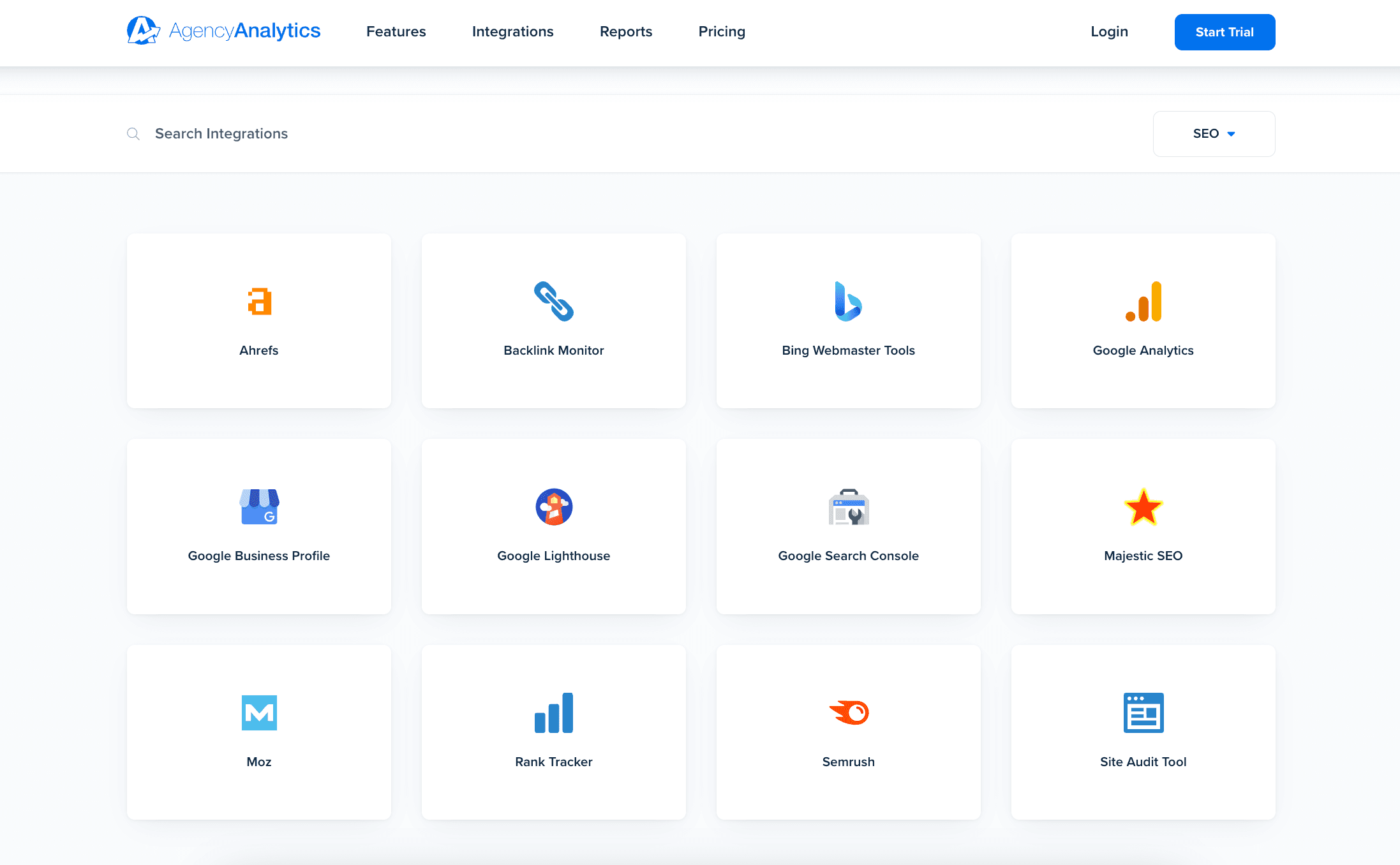
AgencyAnalytics connects to 80 + marketing channels to give your team an overview of your client’s SEO marketing strategies–in one convenient dashboard.
Here are the two of the main things your agency should report on for your clients:
Search volume: How many searches for this keyword are run every month?
Keyword difficulty: How hard is it to rank on the first page of Google’s search results for this keyword?
Rankings: How are their keywords stacking up against their competitors in the SERPs?
Organic traffic: How much traffic are they getting organically from your SEO strategies?
Agency Tip: If your client is just starting out, your agency should generally look for long-tail keywords with decent search volume and low competition.
Now, you may be wondering what qualifies as “decent search volume”, although, as Brian Dean points out in his article on keyword research, that depends on your niche:
For example, a long tail keyword in the fitness niche like “best ab exercises” gets 10K-100K searches per month. But a long tail keyword in a B2B space like digital marketing like “best SEO software” only gets 100-1K monthly searches.
Conduct some research on the search volume for your client’s specific niche to gain a better understanding of what they should aim for.
Once you build up their domain authority, they can start going after more competitive keywords that have high search volume.
Read More: Pros & Cons of the Best Keyword Ranking Tools
2. Build trust and authority with high-quality content
Why: Well-crafted content showcases your clients' expertise, earns trust, and positions them as industry leaders — not just another website in the results.
Google has put a lot of effort into ensuring that the best content rises to the top of its search results. As a rule of thumb, content marketing (including SEO) doesn’t work without creating great content.
Of course, it doesn’t always work out that way, but if your client wants to rank well in the world’s most popular search engine, creating high-quality content is their best bet.
Here are a few considerations:
Match search intent
The most important thing is making sure your client's content matches what people are looking for. Think like their ideal customer for a moment.
The four types of search intent include:
Informational intent: When a user is looking for information. For example, “capital of Mozambique”, “ketogenic diet”, “how to optimize a YouTube video for SEO”, etc.
Transactional intent: When a user is searching for a product they want to buy now. For example, “Moleskine notebook”, “order pizza Barcelona”, etc.
Commercial intent: When a user is researching a potential purchase. For example, “top hotels London”, “best email marketing software”, etc.
Navigational intent: When a user wants to go to a specific website. For example, “Sennheiser United Kingdom”, “Tropical MBA podcast”, etc.
When targeting your client’s keyword, make sure the content aligns with what users expect to find. Otherwise, they’ll likely struggle to rank on Google.
Here’s a helpful table on search intent:
Intent Type | Description | Qualifiers | Examples | Strategy |
|---|---|---|---|---|
Informational Intent | Users who are looking for helpful information but are not currently in the market to purchase a particular good or service. | “What is” “How to” “Best way”
| Recipes, home decor tips, or even advice on SEO. | Provide relevant advice to help solve these users’ basic problems will make it far more likely that they will turn to you when they need to solve their more advanced problems.
|
Navigational Intent
| Users who want to visit a particular brand or website and just aren’t sure what the URL (or address) is for that business. | “Website” or “Online”, location-based keywords, top-level domains (.com, .ca, etc.)
| Searching for unique and distinct company names.
| Make sure that they find your client’s site and not your competition. “Joe’s Plumbing” or “Deluxe Dental” could send the user down a rabbit hole of similarly named businesses. |
Transactional Intent | A user is actively searching for a product or service offered by your client–This is the gold mine for eCommerce sites, as these are the users looking to solve a particular problem by purchasing a product or service. | “Order”, “Buy”, “Coupon”. | Searching for something by name. | Make sure that your client is included within that consideration set.
|
Make it comprehensive
Aim to create the most comprehensive resource on the topic on the internet. Once you understand what users are trying to accomplish, your first priority should be to meet that need directly. When that’s done, think about how to make their content even more helpful than existing results, ie, their competitors.
To accomplish this, put yourself in the shoes of the person who typed this keyword into Google:
What are the problems that they may encounter?
What are the most helpful tips and tricks that can make things easier?
What additional information would they find useful?
It’s important to resist the temptation to simply pad the word count, though. Remember the search intent and ask: “what is the person who typed this keyword into Google trying to achieve?”.
Make it better than the competition
Next, focus on making your client’s content better than their competitors. Not just longer–better. Many SEO practitioners mistake the Skyscraping technique as simply creating a post with more words than the competition, but more fluff will not help your client in the long wrong. More in-depth content will. Analyze the content that’s already ranking on the first page of Google’s search results and identify how to improve on it.
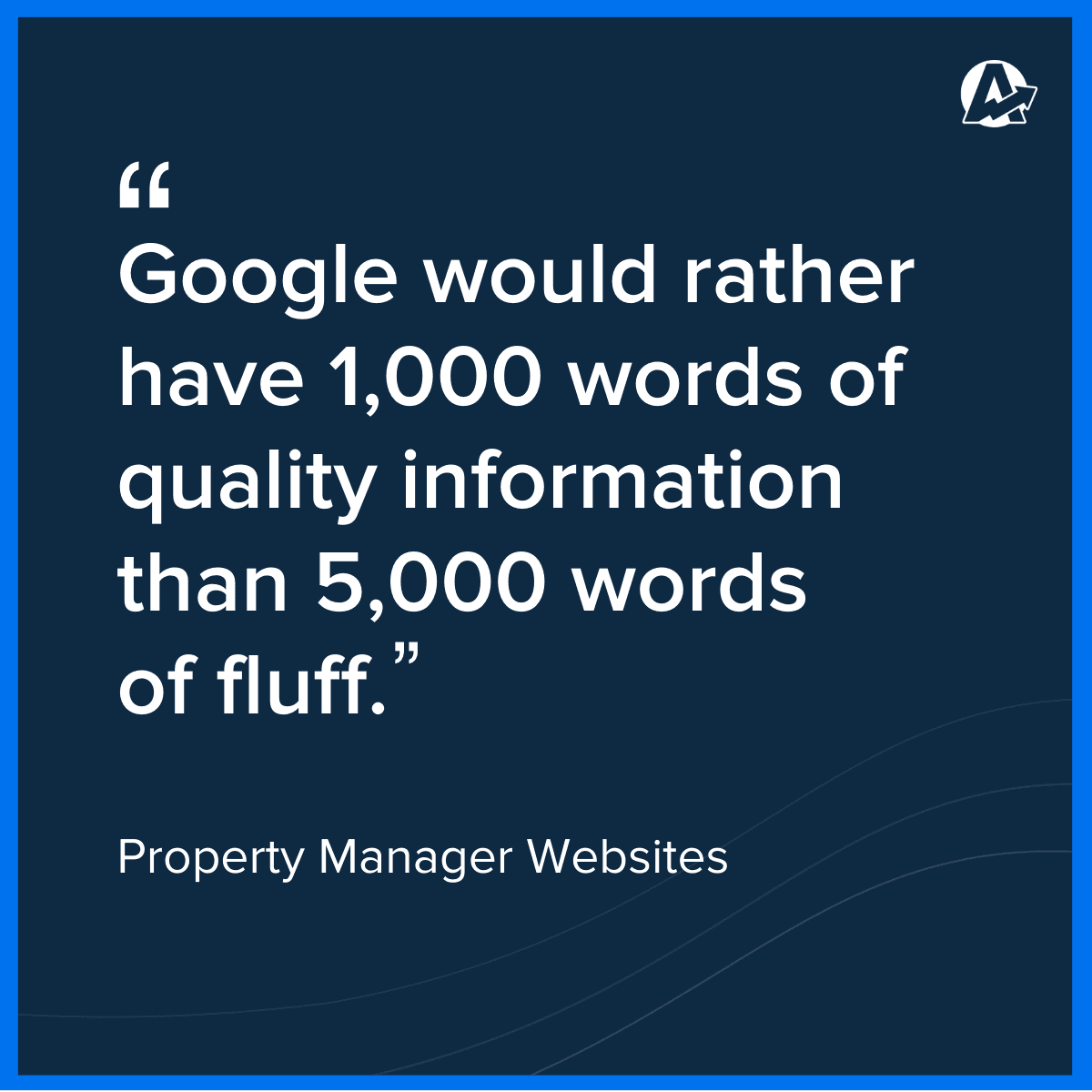
Here are a few ideas:
Think like a helpful expert: When creating content, consider what questions your client's ideal customer might have beyond the main topic. If you're writing about "how to change a tire", anticipate questions about safety precautions, tools needed, or troubleshooting a flat on the side of the road.
Comprehensiveness with Value: While in-depth content often performs well, aim for quality over quantity. Pack your content with valuable information, not just filler words to hit a specific word count.
Outshine the Competition with Specifics: Analyze the content already ranking on the first page of Google for your target keywords. Can you offer more detailed instructions, unique case studies, or better visuals? This is how you create content that truly stands out in the search results.
Unique Insights and Data: Do your clients have exclusive research, survey results, or a thought leader within the company who can provide expert opinions? Including these elements adds a level of authority unmatched by generic articles.
Custom Visuals: Stock photos and generic infographics are a dime a dozen. Can you create original charts, illustrations, or even simple branded diagrams to elevate the content and make it more shareable?
Readability is Key: Even the best content won't perform well if it's a wall of text. Use short paragraphs, subheadings, bullet points, and images to keep things engaging and scannable.
Think Beyond Text: Could you embed a helpful video alongside an article? Turn complex data into an infographic? These multi-format approaches can attract more attention in the search results.
It’s important to understand that the competition for those coveted spots on the first page of Google’s search results is fierce. This means you need to outwork everyone that’s already on it if you want your clients to stand a chance.
How to Choose Which to Include
Consider your client's specific industry and strengths when deciding which additional tips to include. For example:
A SaaS company might benefit from original data or expert opinion pieces.
A local service business could create custom maps, "before and after" image galleries, etc.
An e-commerce site could focus on user-generated content like high-quality product reviews to build trust.

3. Improve content performance with on-page optimization
Why: On-page SEO fine-tunes content for visibility and relevance, ensuring it performs well in both traditional and AI-powered search environments.
Clearscope and SurferSEO are like insider guides to what Google wants to see in top-ranking content. Here's how they help you and your clients:
Get Specific Suggestions: Instead of guesswork, you'll get a list of related terms to include, an optimal word count range, and even readability analysis.
Save Time and Level Up Results Mastering these tools takes a bit of practice, but it's a game-changer for getting clients those coveted top spots in Google, faster.
Content Efficiency: These tools create detailed content briefs, saving your team time on keyword research and ensuring all important topics are covered.
Data-Driven Decisions: Instead of relying on SEO "best practices" alone, you get data-backed insights about what it takes to rank in your specific niche.
Competitive Analysis: These tools reveal what themes, keywords, and structures are working for the top-ranking pages, making it easier to outperform them.
Simply put, the better their content answers the user's query with clarity and relevance, the higher it will rank.
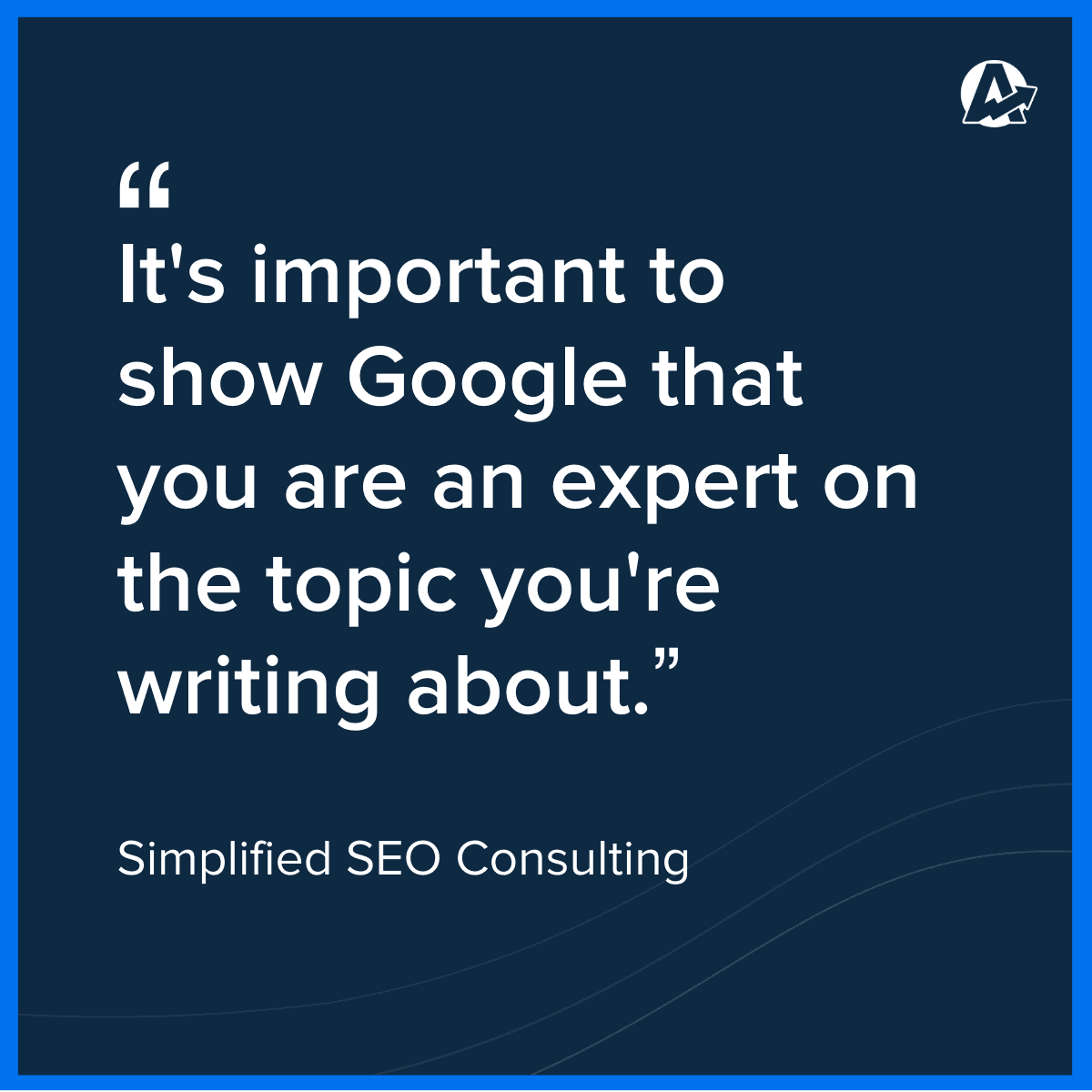
Clearscope’s most valuable feature is optimizing content for relevancy. Paste your client’s article into it, and it displays a score from F to A++. This score is based on word count, readability, and relevance compared to the competition.
Once you have your grade, make adjustments to improve it. For example, include more relevant terms from the list provided by Clearscope. Continue tweaking until you get an A+ or A++ in order to increase your client’s odds of ranking on the first page of Google’s search results.

4. Earn credibility through high-value backlinks
Why: Backlinks from authoritative sources act as social proof for search engines, helping elevate your clients' content and credibility.
Arguably, the second most important aspect of Google’s ranking factor is backlinks, as people linking to a web page indicate that the web page provides value.
The most straightforward way to get backlinks is guest posting, where you offer a free guest post to an established website in exchange for a link to your client’s website. Expect at least one link in your byline, but you may be able to place another one in the post itself.
Of course, if you want to land a guest post, you need to make sure that the article your agency offers on your client’s behalf is top-notch.
Also, keep in mind that all websites are not equal in the eyes of Google. The higher the domain authority of a website, the more valuable a link is from that website.
Here's the key to a strong backlink strategy:
Quality over Quantity: According to Attrock not all backlinks can boost organic traffic and rankings - a single link from a well-known industry website is worth far more than dozens of spammy links.
Relevance Matters: Aim for links from sites that are related to your client's niche. A backlink from a gardening blog for a plumbing company won't carry much weight.
Guest Posting: The Tried-and-True Tactic: Offering high-quality articles to established websites in your client's industry in exchange for a backlink is a great way to build both authority and traffic.
Broken Link Building: Finding relevant websites with broken links (links that lead to 404 errors) and offering your client's content as a replacement.
Press & Media Coverage: Securing mentions or features of your client in online publications can generate high-authority backlinks.
Internal Linking: Thoughtfully linking between related pages on your client's own website improves navigation for users and can gently boost the authority of certain pages.
Use the Ahrefs Website Authority Checker tool to see if it’s worthwhile to submit a guest post to a particular website.
Agency Tip: You generally want to target websites that have a 50+ domain authority. Use the AgencyAnalytics backlink monitoring tool to track your link-building campaign. Show your clients deeper insights about their most valuable links with advanced metrics such as trust flow and citation flow.
5. Strengthen visibility with technical and structured SEO
Why: Fast, well-structured websites that are easy to crawl get prioritized in rankings — and structured data helps your content surface in rich results and AI answers.
Even the best content can be held back by technical issues on your client's website. Here's where to focus for maximum search engine visibility:
Keywords in the Right Places: Make sure to include target keywords in the title tag, meta description, headings, and naturally throughout the content.
Image Optimization: Use descriptive file names, alt-tags, and compression for images to help them rank in image search.
Use structured data to boost visibility in AI-powered results: Implement schema markup (like FAQ, HowTo, Article, or Product schema) to help search engines better understand your client’s content. Structured data increases the chances of showing up in rich results, featured snippets, and AI-generated summaries.
Site Speed Matters: Google favors fast-loading websites. Tools like TinyJPG for image compression, or lightweight website themes can significantly boost speed.
SEO Audit Tools to the Rescue: Regularly run SEO audits to catch broken links, missing title tags, and other issues that can hurt your client's rankings.
Also, if your client’s website was built using WordPress, switching to a lightweight theme, removing unnecessary or having too many plugins, and moving to a blogging platform like, Ghost, help improve page loading speeds.
Read More: Website Audit Essentials
6. Reach new audiences through video content
Why: Video extends your clients’ visibility across search and social, creates deeper engagement, and improves dwell time on key pages.
Video SEO helps your clients gain visibility by ranking well both on YouTube and within traditional Google search results. Optimized videos attract a wider audience on YouTube, leading to more clicks back to their website. Embedding videos on their site also improves engagement and click-through rates in regular search results. This combination directly leads to a boost in their SEO traffic.
Here's how to capitalize on this trend for your clients:
YouTube Optimization: Treat YouTube like its own search engine. Choose keywords people are actually searching for within YouTube, and include them in your titles, descriptions, and tags. Use tools like VidIQ or TubeBuddy to do the right research.
Don't Neglect Your Website: Embedding relevant videos directly on your client's site keeps visitors engaged longer, signals to Google that their website offers valuable content, and can even boost overall dwell time (a positive ranking signal).
Captions & Transcripts: Not only do captions make videos accessible to a wider audience, but they also give search engines more text content to understand what the video is about. It's a win-win.
Think Like a Viewer: Hook people in with eye-catching thumbnails and strong introductions to encourage them to click and actually watch the whole thing. The more watch time your client's videos get, the better for their visibility.
Types of Videos That Work: Don't limit yourself to just one kind! How-to tutorials, product demos, client testimonials, and even short behind-the-scenes snippets can all attract clicks and shares.
Key Takeaway: Video SEO expands your client's reach by showing up in both YouTube search results and traditional Google results, grabbing the attention of a whole new audience.
7. Build brand and social signals that boost long-term visibility
Why: A strong social presence amplifies content, creates brand familiarity, and contributes to the trust signals search engines love.
Social signals don't directly cause your client's website to rank higher. However, by boosting their brand's online presence across different platforms, they indirectly create positive effects that lead to more search traffic.
Here's how a strong social presence helps your clients:
Visibility = Click Potential: Even if someone doesn't follow your client on social media, seeing their brand regularly across different platforms builds awareness. If they later search for something related, they're more likely to recognize your client's name and click.
It's a Signal of Trust: Think of a strong social media presence like a popularity contest. When Google sees lots of engagement on your client's profiles, it indicates that they're a reputable and active business.
Backlink Opportunities: Some social platforms allow for links in profiles, posts, or comments. While those might not be the highest quality backlinks, they can contribute to an overall healthy backlink profile.
Driving Traffic: Even if a social post doesn't lead to a direct backlink, it can still bring valuable referral traffic to your client's site. This can boost overall engagement metrics, which does indirectly influence SEO.
Content Amplification: Your client's blog post might not go viral on its own, but a captivating social post accompanying it can significantly increase the chances of it reaching a wider audience and gaining those valuable backlinks.
Key Takeaway: Social media marketing and SEO should work together. Even activities not directly connected to search will help elevate your client's overall visibility and authority online.
8. Turn customer reviews into ranking power
Why: Online reviews don’t just build trust — they influence local rankings, click-through rates, and overall brand perception across platforms.
In today's world, where people turn to the internet for everything from hailing a cab to finding a new dentist, what other people say about your clients online carries serious weight. This online word-of-mouth can significantly influence their search engine optimization (SEO) success. Here's how reviews and reputation tie into their SEO success:
Local SEO Powerhouse: Positive reviews on Google Maps can significantly enhance your client's visibility in local search results (the map pack that often appears at the top). Aim for a mix of high star ratings and recent reviews.
Trust Signals: Search engines want to show users the best possible results. Numerous positive reviews across platforms like Yelp or industry-specific review sites demonstrate that your client is a reliable and trustworthy business.
Increased Click-Through Rate: Imagine searching for a plumber and seeing two listings. One has 5 stars with glowing reviews, the other has only 2 stars. Which are you going to click? Star ratings in search results can heavily influence people's decisions.
Content for Reviews: Customer testimonials or case studies can be turned into valuable content for your client's website, further showcasing their expertise and building trust.
It's Not Just Google: People look for recommendations everywhere. Actively managing your client's online reputation means staying on top of negative reviews or even addressing issues mentioned in social media comments that could impact how potential customers view them.
Key Takeaway: Encourage your clients to actively solicit reviews from happy customers. Make it easy by providing links and instructions on their website and in email follow-ups. Don't be afraid to address negative feedback professionally to demonstrate excellent customer service.
When should your clients expect to see SEO results?
It's crucial to set realistic expectations with clients. SEO is a long-term game, but some results can be seen relatively quickly. Here's a more nuanced breakdown:
Timeframe | What You Might Expect | What to Watch For |
|---|---|---|
First 1–3 months | Early signs: increased impressions, movement in ranking, user behavior changes | Avoid overpromising rankings; manage expectations |
3–6 months | Consistent organic traffic, initial conversions, more engagement from non‑branded keywords | Focus more on content quality + user experience |
6–12 months | Steady growth, authority building, compounding traffic | Keep iterating — content & technical health matter |
12+ months | Strong brand authority, ranking for competitive keywords, stable organic traffic flow | Maintain content relevance; refresh outdated content and align with new trends (e.g. AI search) |
Expert Tip: Regularly review your client's analytics data and tie those metrics back into clear business goals. This makes the SEO journey feel tangible and demonstrates the value your agency provides.
The takeaway
There’s no way around it: building organic SEO traffic takes time. However, once you turn your client’s blog into a traffic-generating asset, they’ll begin seeing an increase in organic traffic, including unique visitors, without much additional effort.
And all of this effort can be traced back to your agency by using SEO reporting tools. Monitor your clients' key SEO metrics in real-time in a marketing dashboard that keeps you and your clients on the same page.
Clients want to see the progress in SEO efforts, and AgencyAnalytics makes it easy to deliver.

Use a customizable SEO report template or a Local SEO report template to highlight your agency's value. Try AgencyAnalytics free for 14 days!
Impress clients and save hours with custom, automated reporting.
Join 7,000+ agencies that create reports in under 30 minutes per client using AgencyAnalytics. Get started for free. No credit card required.
Frequently Asked Questions about increasing SEO traffic
Clear answers to the SEO questions your clients ask most — backed by what actually works today
Yes — SEO matters more now than ever, but its scope has expanded. AI systems, answer engines, and voice assistants all rely on structured, high‑quality content to generate trusted responses. Traditional SEO signals (content quality, authority, backlinks, user behavior) still form the foundation of what AI pulls from.
But SEO today isn’t only about ranking in a list of blue links. It’s about being the authoritative source that search engines and AI models quote, summarize, and elevate. That requires:
Clear, intent‑aligned content
Structured data markup
Strong topical authority
Demonstrated expertise and trust signals
In other words: SEO remains essential — but today's SEO must optimize for both human searchers and AI‑powered answer engines.
It’s possible, but context matters. Some clients see quick gains when:
Technical issues are fixed (e.g., indexation, Core Web Vitals, broken links)
Under‑optimized pages are refreshed with clearer intent alignment
New content targets low‑competition, long‑tail keywords
Existing pages already have authority but lack structure or clarity
However, significant and sustainable SEO growth usually takes several months. Search engines need time to crawl, understand, and trust your changes. The most reliable results come from consistent improvements in:
Content depth and quality
Internal linking
Backlink growth
Topical authority
User experience
Short‑term wins are possible — but long‑term momentum is where SEO delivers its real value.
Not necessarily. More traffic only helps if it aligns with what your client offers and the actions they want users to take. High‑volume but irrelevant traffic can:
Hurt conversion rates
Inflate bounce metrics
Reduce the website's topical authority
Distract clients from meaningful KPIs
Waste content and optimization efforts
A better goal is to increase qualified, intent‑matched SEO traffic. That means focusing on:
Keywords tied to the right stage of the buying journey
Content that solves specific problems for your client’s ideal audience
Pages designed to nurture visitors toward a clear next step
In SEO, relevance beats volume — every time.
Here are the highest‑impact areas agencies should prioritize:
Align every page with clear search intent: If a page doesn’t match what users expect, it won’t rank — no matter how “optimized” it is.
Create comprehensive, high‑quality content: Depth matters. Search engines reward pages that fully answer a query, anticipate follow‑ups, and demonstrate expertise.
Strengthen on‑page SEO and technical health: Fast, crawlable, structured websites outperform slow or confusing ones — especially in AI‑powered results.
Leverage structured data and answer-ready formatting: Schema markup (FAQ, HowTo, Article, Product) helps search engines understand and surface content in rich results and AI summaries.
Build trust and authority across the web: Quality backlinks, brand mentions, reviews, and reputation signals tell search engines your client is a credible source.
Maintain, update, and expand existing content: SEO rewards freshness and relevance. Older posts often see significant gains with thoughtful updates.
These six actions form a balanced SEO strategy that works across traditional SERPs and answer‑driven discovery.
A strong SEO report goes beyond traffic counts. It should connect SEO performance directly to client goals by showing:
Organic sessions and unique visitors
Ranking improvements for high‑intent keywords
Search impressions and click-through rate (CTR)
Behavior metrics (bounce rate, time on page)
Conversions and assisted conversions
Top‑performing pages and growth trends
New backlinks and authority gains
Pair the data with a short narrative summary that explains:
What changed
Why it mattered
What to do next
This storytelling approach helps clients understand the true impact of your SEO work — and reinforces the value of long‑term investments.
The best approach is a hybrid one. Content that performs well in AI results also tends to perform well in search engines — because both reward:
Clear structure
Helpful answers
Expertise
Updated, trustworthy information
Traditional SEO (ranking in SERPs) brings dependable traffic. AEO (answer engine optimization) brings brand visibility in emerging search channels.
Both matter. Prioritize readability, clarity, schema markup, and intent alignment — and your content will be optimized for both environments.
Best practice for SEO has always been to write for humans first, then optimize for search engines. That doesn't change, it only expands.
Write for humans first. Then adapt for machines. A balanced approach looks like this:
Start with natural, empathetic, helpful content
Use structured headings, lists, and concise summaries
Add schema markup so search engines understand context
Include clear answers to “core questions” in the first 1–2 sentences
Expand with depth, nuance, and examples for the human reader
Update content regularly to maintain accuracy
This hybrid style is what both readers and AI models respond to best.

Written by
Paul Stainton is a digital marketing leader with extensive experience creating brand value through digital transformation, eCommerce strategies, brand strategy, and go-to-market execution.
Read more posts by Paul StaintonSee how 7,000+ marketing agencies help clients win
Free 14-day trial. No credit card required.



